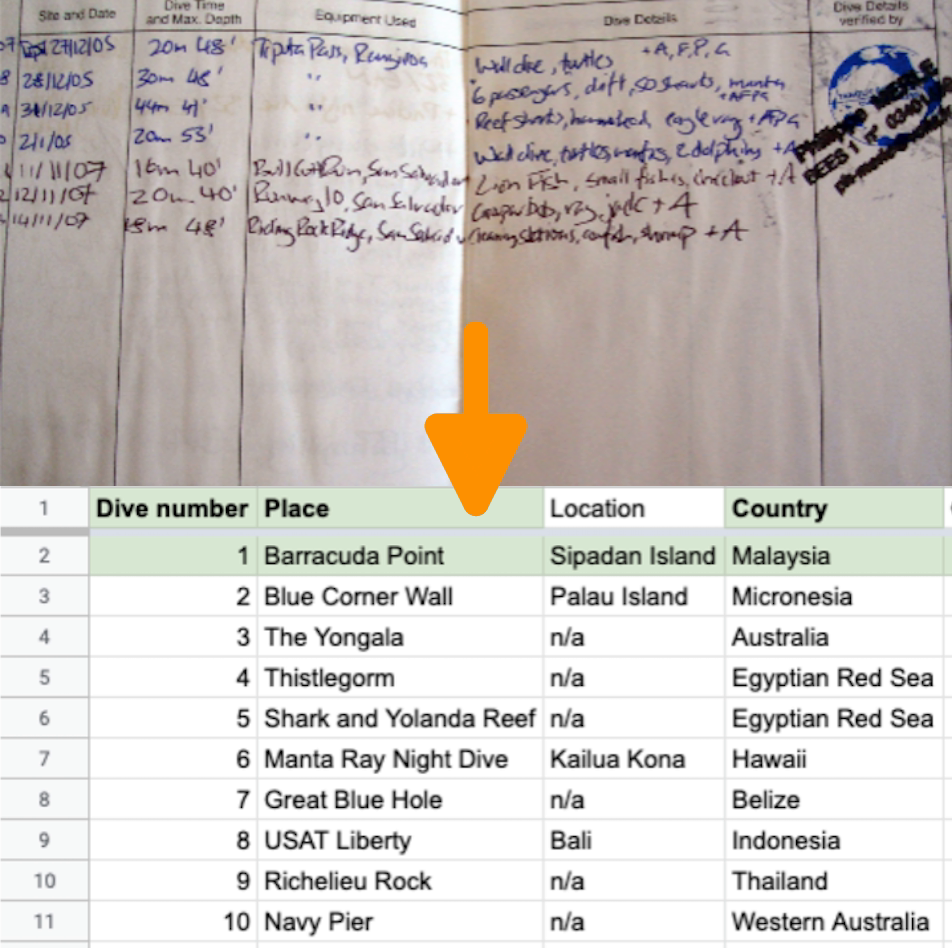Make a Dive Map of Your Scuba Dives
Athletes of exhilarating sports know it’s important to minimize accidents while maximizing fun. For instance, rock climbers use best-practice commands. It’s scuba diving best practice to log each dive upon completion.
To achieve the next level of certification or a technical certificate, divers must present a certain number of logged dives. Additionally, if a diver wants to dive multiple times a day, they must know the depth and duration of previous dives to calculate saturation levels in preparation for the next dive. Divers may also note equipment used and conditions (i.e. fresh or saltwater) to make it easier when planning another dive in similar conditions.
Plus, who wouldn’t want to visualize past dive sites and keep track of the places you hope to experience in the future?
View Dive Map in a full screen map
We added the World’s 10 Best Places for Scuba Diving to a spreadsheet, along with a few more for good measure. Let’s walk through how we made this dive map and how you could do the same with your own under-the-sea moments. It all starts with a simple spreadsheet.
Types of Dive Locations to Log in a Spreadsheet
Bring your dive logs into the 21st century with the help of a spreadsheet. Microsoft Excel or Google Sheets are both great tools to store your essential diving data. A spreadsheet version of a dive log allows you to do things you just can’t with pen and paper. To start, let’s go over the basic location-related headings you’ll need to create a dive log.
Dive site: Whether it’s Castle or Canibal Rock, you of course want to note the dive sites you visit. Keep track of these to avoid going to the same site twice or to ensure you remember your favorite site.
City, state, and country: Remove the confusion of two dive sites with the same name when you include the city, state, or country where the dive site is located. This is also crucial information needed for your dive map later on. If you want to get advanced you can map the latitude and longitude of your locations.
Interactive Maps Made Easy
Sign Up NowHowever you track your location, that’s just the start of what you can include in your dive log spreadsheet. So what additional information can we add?
More Spreadsheet Columns for Your Dive Map
Of course, there’s more to scuba diving than location. Other factors that affect the safety and logistics of your dives are a must to track. If you have to note them, you may as well make it easy with a spreadsheet. Some of the additional factors that could be column headings include:
- Dive number
- Date
- Entrytime
- Depth
- Duration
- Equipment (such as the thickness and type of wetsuit, etc.)
- Conditions (including water type)
- Fellow divers
- Where you’ve been & want to go
- Image
- Comments
Not only are you storing this key data in an organized way, but you’ll also be able to sort your dive map by several of these categories. Our mapping tool’s grouping feature allows you to sort the map by this extra info. See for yourself how useful grouping can be when you make your own dive map.
Map Your Scuba Dive Spreadsheet
Once you have your spreadsheet, input it into our mapping tool by following the steps below.
- Open your spreadsheet
- Select (Ctrl+A or Cmd+A) and copy (Ctrl+C or Cmd+C) your data
- Open your web browser and navigate to batchgeo.com
- Click on the location data box with the example data in it, then paste (Ctrl+V or Cmd+V) your own data
- Check to make sure you have the proper location data columns available by clicking “Validate and Set Options”
- Select the proper location column from each drop-down
- Click “Make Map” and watch as the geocoder performs its process
The result is a dynamic custom map of your dive site locations. You can sort it based on the additional data from your spreadsheet and dive into the data within your map and share your experiences with others.
Share Your Dive Map With Friends & Fellow Divers
While a dive map for your own logging purposes is extremely useful, it’s even better when you can share it with friends and fellow scuba divers. Doing so is easy via a web or mobile device.
Share the link to your dynamic map with friends or embed it on your website so that the world can see all the dive sites you’ve visited (or want to visit). Yet, a scuba dive map isn’t the only map you can make with your data and share with your friends. For the less aquatically-inclined, a map of my location and favorite places applies to anyone who has ever left the house.

